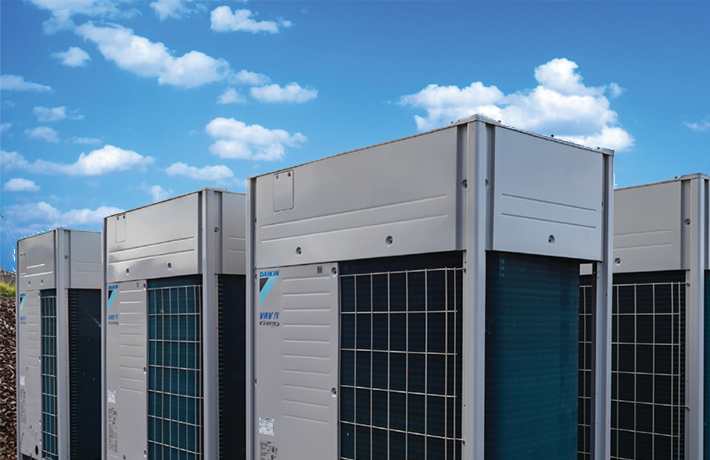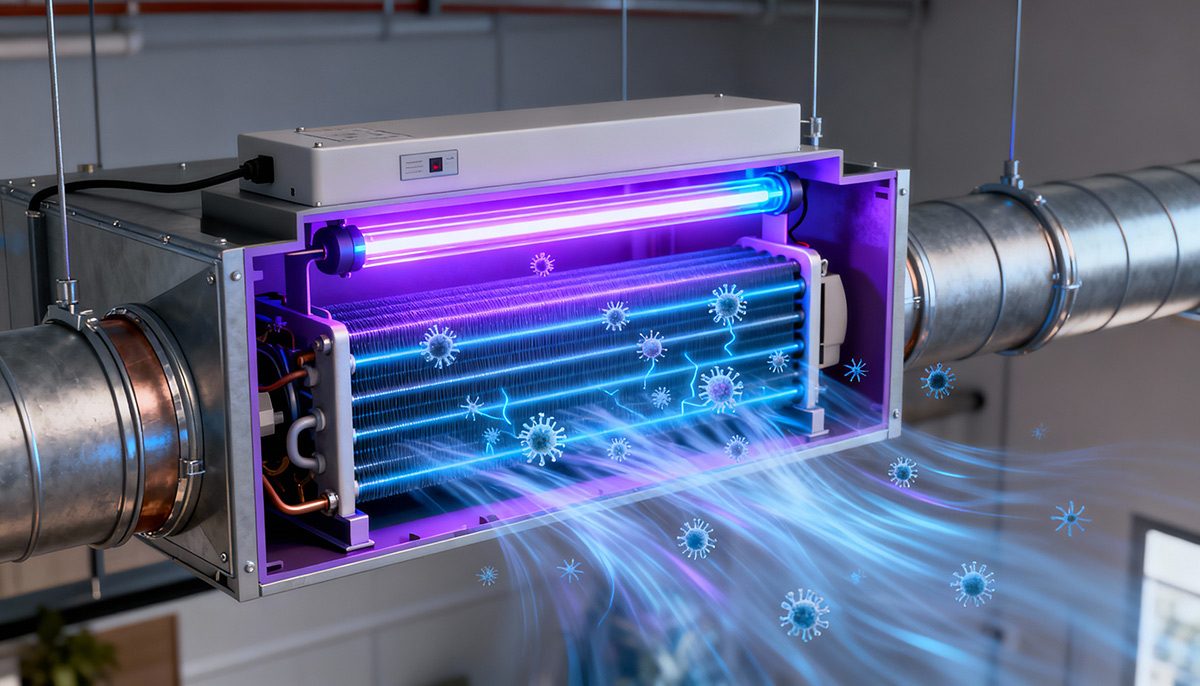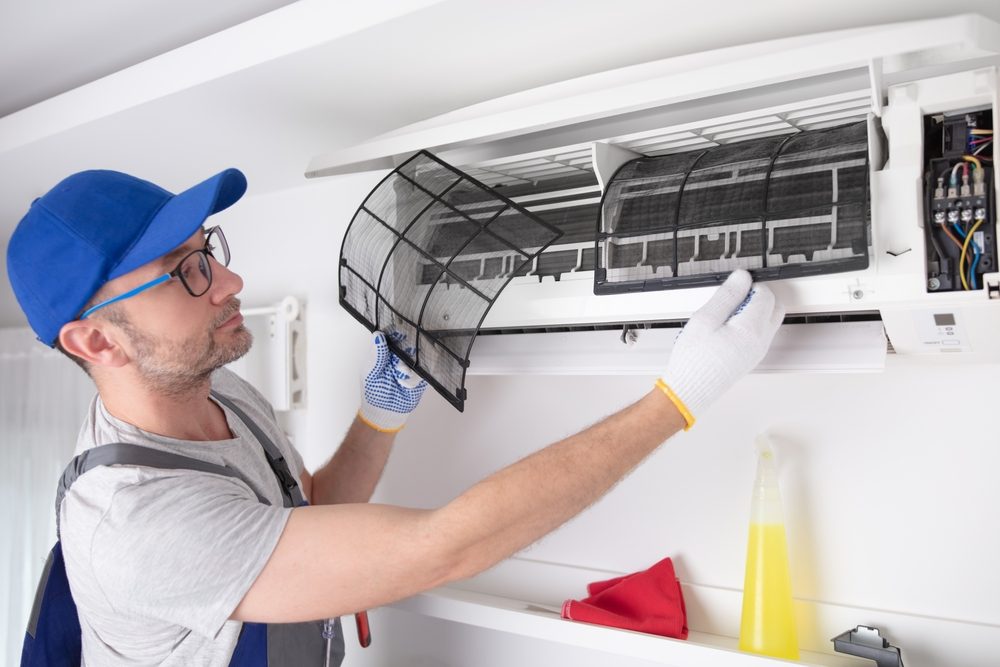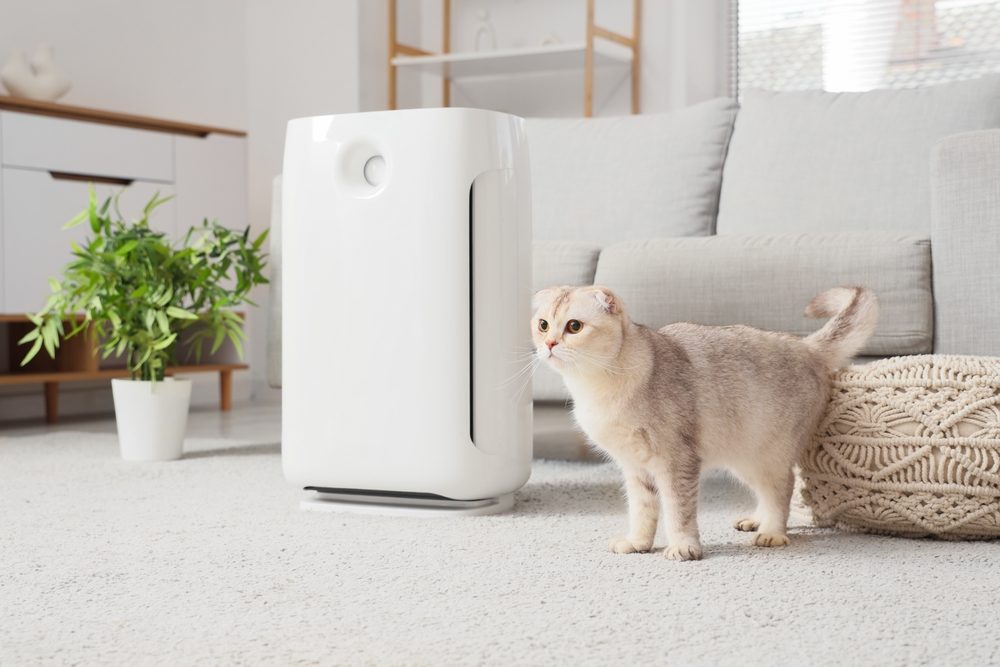
Let’s start with an introduction to VRV systems. Essentially they work by adjusting the refrigerant volume in a system to precisely match a building’s requirements. This mechanism ensures energy efficiency by delivering or extracting heat to individual zones using refrigerant-to-air heat exchangers, with multiple indoor units and a refrigerant flow distributor control device. By maintaining set temperatures and automatically shutting off when no occupants are detected, VRV systems are more sustainable in the long run, helping end users save on energy costs and reduce carbon emissions. One thing to note, VRV is the trademarked technology by industry-leaders Daikin. It is also known as VRF (variable refrigerant flow) systems.
So let’s now dive in more deeply and look at how exactly VRV systems operate as well as their many applications.
Understanding VRV technology
Let’s now look at VRV in a little more detail. The technology comprises an air conditioning system that allows greater energy efficiency and comfort control. They can connect up to 64 indoor units to a single outdoor unit, operating in a similar way to a Multi-Split system but with additional functionality and efficiency.
Each indoor unit in a VRV system independently determines the capacity it requires based on the current indoor temperature and the set point specified by the user via a remote control. This decentralized approach ensures precise climate control tailored to the needs of individual zones within a building. The total demand from all indoor units dictates how the outdoor unit will then adjust the refrigerant volume and temperature, ensuring that only the necessary amount of cooling or heating is provided.
One of the main components of VRV technology is the inverter compressor. Unlike traditional compressors that operate at a constant speed, an inverter compressor can vary its speed to match the cooling or heating demand. This results in substantial energy savings, as the system avoids the frequent on-off cycles that waste energy.
The advantages of VRV technology extend beyond energy savings. Its ability to provide zoned climate control enhances comfort for occupants, as each area can be set to a different temperature based on specific requirements. This flexibility is particularly beneficial in buildings with diverse usage patterns, from offices to hotels or even multi-storey residential complexes.
VRV cooling systems: How do they work?
Let’s now look at a step-by-step process of how VRV systems operate.
1. Initial setup and configuration
- Installation: VRV systems begin with the installation of an outdoor unit, multiple indoor units, and the refrigerant piping connecting them. Each indoor unit is then configured to meet the specific cooling or heating requirements of its designated zone.
2. Temperature detection and demand assessment
- Indoor units: Each indoor unit is equipped with sensors to detect the current indoor temperature and compare it with the set temperature chosen by the user. Based on the difference between the current temperature and the set point, each indoor unit calculates its cooling or heating demand.
3. Communication and signal transmission
- Signal transmission: The indoor units send their respective cooling or heating demands to the outdoor unit through the control system.
4. Adjustment of refrigerant flow
- Outdoor unit: The outdoor unit receives the combined demand from all indoor units and adjusts the refrigerant volume and temperature accordingly. This is achieved through the use of an inverter compressor, which can vary its speed to match the required load.
- Refrigerant piping: VRV systems begin with the installation of an outdoor unit, multiple indoor units, and the refrigerant piping connecting them. Each indoor unit is then configured to meet the specific cooling or heating requirements of its designated zone.
5. Cooling or heating delivery
- Heat exchangers: The indoor units use refrigerant-to-air heat exchangers to transfer the cooling or heating effect to the air in the room.
- Fan operation: Fans within the indoor units circulate the conditioned air throughout the space, maintaining the desired temperature.
6. Energy efficiency and automatic adjustments
- Inverter compressor: The inverter compressor continuously adjusts its speed to maintain the optimal refrigerant flow, ensuring energy efficiency by avoiding frequent on-off cycles.
- Occupancy sensors: Some VRV systems are equipped with occupancy sensors that can detect when a room is unoccupied. In such cases, the system can reduce or stop the cooling or heating to save energy.
7. Feedback loop and continuous monitoring
- Temperature feedback: The indoor units continuously monitor the room temperature and provide feedback to the outdoor unit, allowing for ongoing adjustments to refrigerant flow.
Applications of VRV cooling systems
Let’s look at three key applications for VRV cooling systems.
Residential applications: VRV technology offers homeowners the ability to control individual zones within the home so that each room can be set to the desired temperature, enhancing overall comfort. This zoned approach also translates to energy savings, while the quiet operation of VRV systems and their compact nature makes them ideal for the home.
Commercial applications: VRV systems work very well in commercial settings, such as office spaces, retail stores, hotels, and more. The ability to connect multiple indoor units to a single outdoor unit provides flexibility in design and installation, accommodating diverse floor plans and varying occupancy patterns. All while keeping operational costs low.
Industrial applications: Warehouses, manufacturing plants, and large industrial complexes often have vast spaces with varying temperature needs. VRV systems can effectively manage these diverse requirements by providing precise climate control for different zones within the facility. This capability is crucial for maintaining optimal conditions for equipment, products, and worker safety as well as uninterrupted performance.
Daikin: Leading the way in VRV technology
Daikin’s history is rooted in providing safe, healthy, and comfortable spaces throughout a building’s life cycle. The company’s world-leading technology ensures optimal indoor air quality and minimal environmental impact. Through continuous innovation and collaboration with partners and customers, Daikin strives to create a healthier world.
Daikin is the inventor of the VRV (Variable Refrigerant Volume) system in 1982, and today is still driven by a commitment to sustainability and innovation. Its flagship offering – the VRV 5 Heat Recovery system – is a next-generation climate control solution designed to support the decarbonisation of buildings. It boasts dynamic features that ensure maximum comfort and flexibility while significantly reducing a building’s environmental footprint.
Meanwhile, the VRV IV+ heat pump, VRV X Cooling Only, and VRV IV S-series units are also available, offering a variety of solutions tailored for different usages and applications. Whether you need efficient heating and cooling for residential spaces, versatile climate control for commercial buildings, or specialized systems for industrial environments, Daikin provides comprehensive options to meet diverse needs.
Conclusion
As the top indoor comfort solutions company globally, Daikin understands the importance of the air we breathe. That’s why we’re dedicated to changing how people approach making their homes, businesses and organizations more comfortable. With over 90 years of experience, Daikin has sold millions of systems in 140 countries. With a strong focus on environmental regulations, health & safety, and energy efficiency, Daikin has a holistic approach to sustainable refrigerant management. Innovative, pioneering technology paired with exceptional service makes Daikin a leading HVAC manufacturer. If you would like to find out more about Daikin’s products, contact us today.



